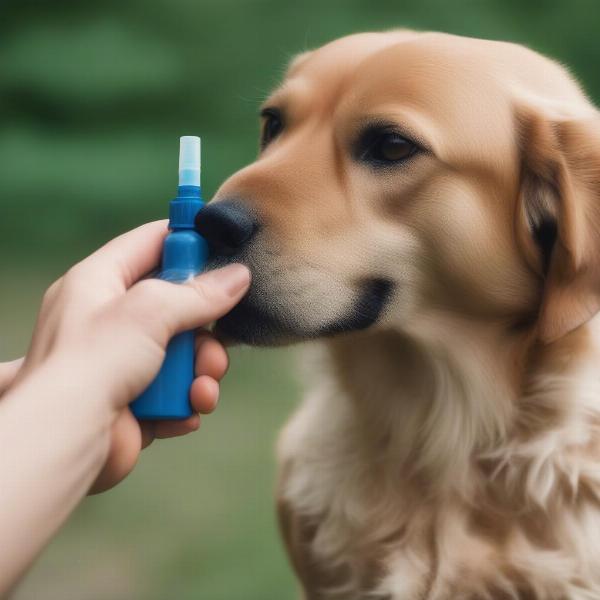Finding a safe and effective way to protect your furry friend from fleas and ticks is a top priority for any dog owner. Natural sprays offer a compelling alternative to traditional chemical treatments, especially for those concerned about potential side effects. This article explores the world of natural sprays for fleas and ticks on dogs, providing you with the information you need to make an informed choice.
Understanding Natural Flea and Tick Sprays
Natural flea and tick sprays utilize plant-based ingredients, such as essential oils, to repel and sometimes even kill these pesky parasites. These sprays offer a gentler approach compared to harsh chemicals, making them a popular choice for dogs with sensitive skin or owners seeking eco-friendly options. However, it’s essential to choose a product with proven efficacy and understand that “natural” doesn’t always equate to “safe.” Certain essential oils can be toxic to dogs if ingested or applied in high concentrations.
Choosing the Right Natural Spray
The sheer variety of natural flea and tick sprays available can be overwhelming. Look for products containing ingredients like citronella, lemongrass, cedarwood, peppermint, or geranium oil, which are known for their insect-repelling properties. Always check the label to ensure the spray is specifically formulated for dogs and follow the instructions carefully. Consider your dog’s size, breed, and any existing health conditions when selecting a spray.
Are Natural Sprays Effective?
While natural sprays can be effective, their potency often varies depending on the specific ingredients and their concentration. They may not be as powerful as chemical treatments in eliminating existing infestations, but they excel at preventing new ones. For best results, combine natural sprays with other preventative measures, such as regular grooming and cleaning your dog’s environment.
How to Apply Natural Flea and Tick Spray
Before applying any spray, always test it on a small area of your dog’s skin to check for any allergic reactions. Apply the spray evenly over your dog’s coat, avoiding the eyes, nose, and mouth. Pay particular attention to areas where fleas and ticks are likely to hide, such as the ears, neck, and belly. Reapply the spray as directed on the product label, especially after swimming or bathing.
Safety Precautions
While generally considered safe, natural sprays can still pose risks if used incorrectly. Never use a spray intended for humans on your dog, as the concentrations of essential oils can be harmful. Keep the spray out of reach of children and pets. If your dog exhibits any adverse reactions, such as excessive scratching, vomiting, or lethargy, discontinue use immediately and consult your veterinarian. dog anti-itch spray can be helpful in these cases.
 Applying Natural Flea and Tick Spray Safely
Applying Natural Flea and Tick Spray Safely
Natural Flea and Tick Prevention: A Holistic Approach
Dr. Emily Carter, a veterinarian specializing in canine health, emphasizes a holistic approach to flea and tick prevention. “Natural sprays can be a valuable tool, but they work best as part of a broader strategy. Regular grooming, cleaning your dog’s bedding, and maintaining a clean environment are crucial for minimizing the risk of infestation.”
Dr. Carter also recommends consulting with a veterinarian to determine the most suitable natural spray for your dog’s specific needs. “Every dog is different, and what works for one might not work for another,” she explains. “Your veterinarian can help you choose a safe and effective product based on your dog’s breed, age, and health status.”
Conclusion
Natural sprays offer a gentle and eco-friendly approach to flea and tick prevention for dogs. By carefully selecting a product with proven ingredients and following the instructions diligently, you can provide your furry friend with effective protection against these troublesome parasites. Remember to combine natural sprays with other preventative measures for optimal results. best flea dog provides additional information on flea prevention strategies.
FAQ
- Are natural flea and tick sprays safe for puppies? Some natural sprays are safe for puppies, but always check the label for age restrictions.
- How often should I apply a natural flea and tick spray? Follow the instructions on the product label, but generally, reapplication is necessary every few days or after bathing.
- Can I use a natural spray if my dog already has fleas and ticks? While natural sprays can help repel further infestation, they may not be as effective in eliminating existing ones. Consult your veterinarian for treatment options. is there a dry shampoo for dogs might be a good option for cleaning your dog after treatment.
- What should I do if my dog has an allergic reaction to a natural spray? Discontinue use immediately and contact your veterinarian.
- Are natural sprays effective against all types of ticks and fleas? Effectiveness varies depending on the specific product and the type of parasite.
- Can I make my own natural flea and tick spray? While possible, it’s crucial to research safe and effective recipes and use caution when handling essential oils. natural flea and tick prevention for dogs canada offers some recipes for DIY sprays.
- Are there any natural sprays that also work as a deodorizer? Yes, some natural sprays combine flea and tick repellent properties with a pleasant scent. fresh and clean dog spray could be a suitable option.
ILM Dog is a leading online resource dedicated to providing dog owners worldwide with expert advice and practical tips on all aspects of dog care. From breed selection and health care to training and nutrition, ILM Dog offers a wealth of information to help you raise a happy and healthy canine companion. Contact us today for personalized guidance and support: Email: [email protected], Phone: +44 20-3965-8624. We’re passionate about helping you provide the best possible care for your furry friend.